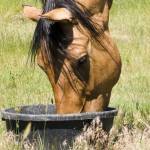Are You and Your Horse Ready for Trail Riding?

For many horse owners, spring weather means a return to trail riding. To guarantee that you and your horse are prepared for a great ride, begin planning well before your first venture onto the trails. If you’ve taken the winter off, both of you need to get back in physical condition, and this means at least four to six weeks of regular riding, beginning with short periods of easy work and progressing to several hours at faster gaits. Hint: If your legs or back are tired or stiff for a day or so after your rides, your horse feels the same way!
During this same four to six weeks of preparation, look over all your tack, blankets, buckets, portable corral, and other equipment. Worn, broken, or ill-fitting items need to be repaired or replaced well before you hit the trail. Don’t try out a new saddle or bit on the day of your big ride.
Transporting your horse to the ride location means you will need to carry health papers. To be sure these are current, check with a veterinarian a month or so before your trip. If your horse needs a Coggins certificate or other documentation, this will give you time to get all his papers in order. It’s also a good idea to schedule vaccinations, deworming, dental work, and trimming or shoeing before the last minute.
Look your trailer over carefully several weeks ahead of time. You need to check tires (condition, inflation), brakes (wiring, battery), interior (sharp edges, broken parts, wasp nests), lights inside and out, flooring, ramp, hitch mechanism, door latches, exterior tie rings, and so on. Take unneeded items out of the tack area and give everything a thorough cleaning.
Your truck needs a going-over also. Look at fluid levels, engine belts and cooling system, brakes, tire condition (including the spare tire), hitch mechanism, and wiring. Do you have several duplicate truck keys distributed among the people who will ride with you? If not, get those keys made and think about places to locate them.
Does your horse load reliably? If not, practice a lot in a calm setting. Don’t wait until the day of the ride when your horse may pick up on your excitement, plant his feet, and refuse to approach the trailer.
No one wants to think about breakdowns, flat tires, or other transportation problems, but they do occur from time to time. Consider registering with an emergency service that caters to horses and riders; check with your trailer dealer for some possibilities.
Remember, everything on this list should have been well started, and maybe even completed, at least a month before your trail ride. At that point, you’ll know you and your horse are on the way toward a wonderful weekend, and you still have time to look at maps, make reservations, plan meals, pack clothes, think about hay and feed, arrange for someone to care for your stay-at-home horses and pets…and look forward to a great trail ride!








